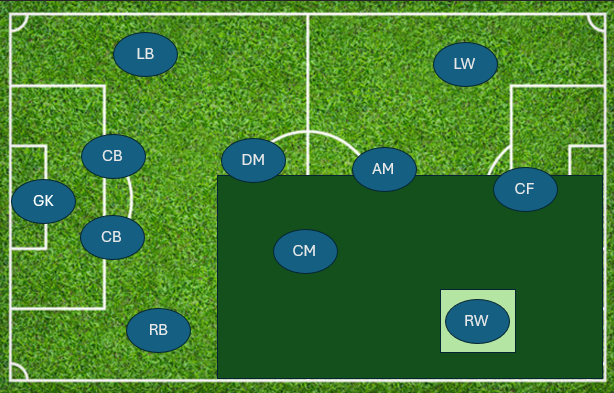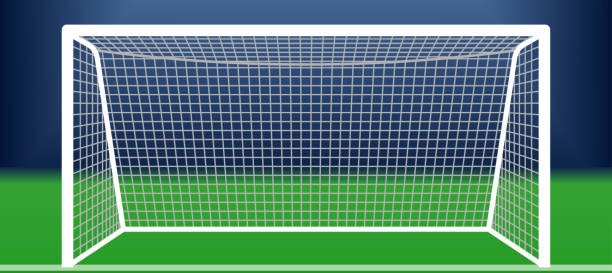RIGHT WINGER.

The right winger in football is an attacking player who operates primarily on the right flank of the field. Their main responsibilities include providing width, creating goal-scoring opportunities, and contributing to both offensive and defensive plays. Here’s a detailed breakdown of the right winger’s role:
Positioning:
- ▫ WIDE ON THE RIGHT FLANK: The right winger is positioned on the right side of the pitch, staying wide to stretch the opponent’s defense and create space for teammates.
- ▫ HIGH ATTACKING POSITION: Typically plays high up the field, often level with or slightly behind the team’s forwards, allowing them to attack quickly.
- ▫ TOUCHLINE OR INVERTED WINGER: Right wingers can either hug the touchline and deliver crosses or, as inverted wingers, cut inside onto their stronger foot for shooting opportunities.
Primary Role: Attacking and Creating Chances
- ▫ PROVIDING WIDTH: The right winger stretches the defense, allowing central players more room to operate and creating gaps for attacking runs.
- ▫ CROSSING: A key duty is delivering accurate crosses into the penalty area for forwards to finish. Effective crossing can lead to high-quality scoring chances.
- ▫ CUTTING INSIDE: Many right wingers, especially left-footed players, will cut inside towards the center of the field, creating shooting opportunities or passing lanes.
- ▫ DRIBBLING: Right wingers are often skilled dribblers, capable of taking on defenders in one-on-one situations to break down defenses.
Supporting the Forward Line:
- ▫ ASSISTING THE MAIN STRIKER: Right wingers frequently provide assists through crosses and passes, playing a vital role in goal creation.
- ▫ SECONDARY GOAL SCORER: They are expected to score goals themselves, especially when cutting inside, thus serving as an additional threat alongside the main striker.
- ▫ COMBINATION PLAY: Right wingers often link up with the right-back and midfielders through quick passing sequences to advance the ball into the attacking third.
Defensive Responsibilities:
- ▫ TRACKING BACK: Right wingers must also support the right-back defensively, tracking back to help defend against opposing attacks, particularly from the left flank.
- ▫ PRESSING: They play a crucial role in pressing the opponent's defenders or midfielders, aiming to win back possession high up the pitch.
- ▫ MARKING AND COVERING: Wingers need to mark the opposition’s left-sided players during defensive phases, particularly during set pieces or counterattacks.
Tactical Variations:
- ▫ TRADITIONAL WINGER: A classic right winger stays wide and focuses on delivering crosses, often seeking to beat defenders on the flanks.
- ▫ INVERTED WINGER: An inverted right winger will cut inside onto their stronger foot, increasing goal-scoring opportunities and creating space for overlapping full-backs.
- ▫ WIDE FORWARD: In formations like 4-3-3, the right winger acts as a wide forward, concentrating more on goal-scoring and less on traditional wing responsibilities.
Skills and Attributes:
- ▫ PACE: Speed is crucial for wingers to beat defenders and recover defensively.
- ▫ DRIBBLING ABILITY: Good dribbling skills are essential for maneuvering past defenders and creating chances.
- ▫ CROSSING: Delivering accurate and effective crosses is a primary skill of a right winger.
- ▫ SHOOTING: They should be capable of scoring from various positions, especially when cutting inside.
- ▫ TACTICAL AWARENESS: Understanding when to stay wide or cut inside is key for exploiting defensive weaknesses.
- ▫ STAMINA AND WORK RATE: Wingers need high stamina to cover large distances and maintain defensive responsibilities.
Formations and the Right Winger's Role:
- ▫ 4-3-3 FORMATION: In this setup, the right winger operates as one of three forwards, focusing on width, crossing, and goal-scoring.
- ▫ 4-4-2 FORMATION: In this traditional setup, the right winger is part of the midfield, balancing attacking duties with defensive responsibilities.
- ▫ 3-4-3 FORMATION: The right winger plays as a wide forward, emphasizing offensive contributions while relying on wing-backs for defensive cover.
